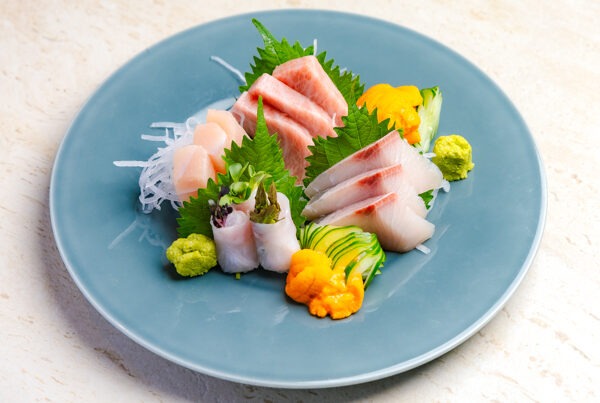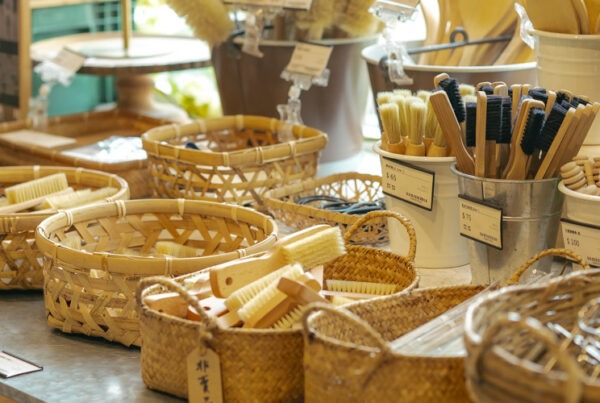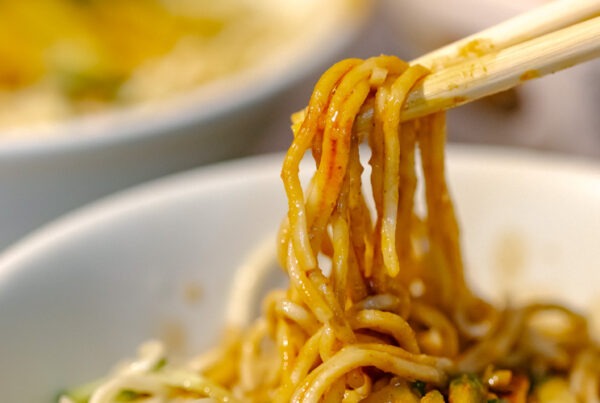Exploring One of Taipei’s Historic Districts
TEXT | RICK CHARETTE
PHOTOS | VISION
The timeless yet simultaneously progressive Dadaocheng neighborhood, by the Tamsui River on Taipei City’s west side, is a must-check day-outing experience with international visitors. This is one of the original pioneer settlement locations, founded in imperial times, around which today’s modern city was built. Visit the neighborhood to explore some of its many vibrant young cultural-creative ventures while immersing yourself in its deep history.
Let’s start our day excursion by filling up our gastronomic gas tank at one of Dadaocheng’s most beloved hangouts for traditional hot snacks, the boisterously busy large square fronting Dadaocheng Cisheng Temple, one of the old-time spiritual and cultural hearts of the district.
Dadaocheng Cisheng Temple
Throughout Taiwan’s history, the squares before temples have commonly been hotspots of commercial activity, attracting food and other vendors catering to the needs of worshippers arriving from near and far. In times past it was also common for a major business thoroughfare to then take root, growing outward from the square.
The original version of this temple – dedicated to Mazu, Goddess of the Sea – was erected in 1866, located very close to today’s Dadaocheng Wharf and overlooking the flourishing local riverport scene. It was rebuilt at its present location in the 1910s after the first was torn down by the Japanese (rulers over Taiwan 1895~1945) to facilitate road replotting, using original pillars and stones. Visitors to Dadaocheng have long made special trips to its courtyard food market, home to 40-plus vendors, to try the culinary specialties, many island-renowned.


Ye Family Meat Congee
Enough talk – let’s get eating! The signature offering at Ye Family Meat Congee, today run by the fourth generation, is considered among the top sold in Taipei. Congee features grains softened from cooking that remain whole while only minimally starchy. Pork and sweet potato chunks are normally added to the delicately flavored broth, and the dish is usually accompanied by savory side dishes. The most-ordered sides at Ye Family are the fried squid, pork liver, and oysters, plus the soy-braised pork belly.

Xu Zai Pork Trotter Vermicelli
Xu Zai Pork Trotter Vermicelli, like our just-visited congee operation, is a family-run venture, making bellies happy for over 50 years. The clear broth that comes with the signature dish is rich and moderately zesty while being free of any greasiness, and the chewy, tender meat, always exceedingly fresh, is lightly fatty giving it a pleasant texture. Your bowl is topped with ginger slices for a hint of spicy heat.
Among the other snack classics prepared at the vendor bazaar are four-tonics soup, squid soup, pig blood soup, pork rib soup, and whitebait fried rice. In Taiwanese xiaochi (“small eats”) snacking culture, sampling a little bit of everything is the definitive modus operandi. Here, chowing down under shady old banyan trees in a temple forecourt adds a unique charm to the experience.


Qinjing Old Warehouse
Qinjing Old Warehouse is a vintage/antiques store immediately south of Cisheng Temple, along the same narrow lane on which the temple’s food vendors are strung out. This is an archetypal old-time Taiwan alley of elderly narrow-front mixed-use residential/commercial buildings, three to four stories tall with additional smaller jerry-built structures added on the roofs, the first floor given over to shops, remaining floors to living accommodations.

The “warehouse” is a shop jammed to the rafters with treasures from everyday Taiwan life the owner has collected over a lifetime, starting in his childhood, when he developed a passion for visiting just-abandoned homes and businesses to hunt for collectibles. Everything displayed is for sale.
Your trip down memory lane – well, new “Taiwan memories” for travelers from abroad – will include such exotic take-home souvenir items as oil-paper umbrellas made in Meinong – a Hakka township in southern Taiwan – Chinese deity figurines, Japanese-style money-beckoning cats from izakayas, manual shaved-ice machines, pop bottles with Hey Song Sarsaparilla and drinking glasses with Taiwan Beer and other local-brand logos, and both traditional Taiwanese and Japanese doll figures. The owner’s collecting goes ever on, and he promises customers new treasures with each visit.


Qinjing Old Warehouse | 秦境老倉庫
Add: No. 11, Ln. 49, Bao’an St., Datong Dist., Taipei City
(台北市大同區保安街49巷11號)
Tel: 0921-067-050
Hours: 11:30am-5:30pm (closed on Sun)
First Record Shop
Your guide on a sensory-rich journey into the sounds of Taiwan’s past is First Record Shop. It inhabits a heritage commercial building dating from the Japanese period sporting a façade that curves around the street corner it sits on, as does the arcade that runs along at street level. Shade-providing, rain-protection arcades are a quintessential feature in the commercial architecture of this era, introduced by the Japanese after seeing their efficacious use in Southeast Asia.

The record shop is a Dadaocheng icon, in operation for over six decades now. This is a retro gold mine – “golden oldies,” that is – packed to the gills with vintage Taiwan-idol vinyl records and LPs, cassettes, and CDs. In its heyday, Taipei folk would come to spot celebrities here, who would come to browse in the hip shop after leaving the popular theaters, dance halls, and other large-scale places of entertainment in the area. The store took its name from the famed, now-defunct First Theater, located diagonally across the street. Adding to the old-fashioned flavor of your experience while you hunt for your Teresa Teng serendipity souvenir will be the visual of one of the elderly proprietors with eyes glued to the old box TV propped up on a corner shelf.

First Record Shop | 第一唱片行
Add: No. 88, Bao’an St., Datong Dist., Taipei City
(台北市大同區保安街88號)
Tel: (02) 2557-9029
Hours: 8am-5pm (Sat/Sun from 9am)
Sin Hong Choon Tea Shop
Tea, along with camphor, was at the heart of Dadaocheng’s rapid development after its settlement in the 1850s. Leaf was grown in the hills surrounding the Taipei Basin, brought here for processing, and river-boated to ships awaiting at the port of Tamsui on the north coast to be then sailed around the globe.
The elegant Sin Hong Choon Tea Shop is in a stately three-story building erected in 1934 as a tea-processing factory – the area’s largest. Sporting a yellow-tinted exterior, it is a synthesis of Taiwanese and Western architectural elements, including terrazzo stairs and red-brick walls inside. The facility was used by the resident owner-family in tea export to Southeast Asia.

After being abandoned for a time and slowly deteriorating, the building was bestowed protected heritage status in 2009 and, after thoroughgoing restoration, was reopened with a new tourism-oriented mission in 2015 – museum, cultural education center, and shop.
The premises have been faithfully given the countenance of a 1930s tea merchant operation. The displays and presentations, with some English available, roll out an understanding of Taiwan’s old-time tea trade, types of leaves, processing methods, and the historic building’s restoration. You’ll especially enjoy the presentation of the owner family’s living quarters and of the heritage tea-processing machinery, learning how leaf was separated from stems and sorted by size, how it was slow-roasted over charcoal, etc. (you’ll still see these traditional practices used at tea farms throughout Taiwan). Then, at the quaint traditional-look retail shop, browse fine teas, tea-theme books, and other offerings.



Sin Hong Choon Tea Shop | 新芳春茶行
Add: No. 309, Minsheng W. Rd., Datong Dist., Taipei City
(台北市大同區民生西路309號)
Tel: (02) 7756-3910
Hours: 10am-6pm (closed on Mon/Tue)
Kuo’s Astral Bookshop
Kuo’s Astral Bookshop, one of Dadaocheng’s largest independent bookstores, is on Dihua Street, Taipei’s oldest commercial street, which began to form in the 1850s when the site was settled by refugees from the upriver Bangka (Wanhua) settlement after fighting between Han Chinese settlers from different areas in China’s Fujian Province. Dihua and its offshoot streets teem with family-run heritage shophouses selling medicinal herbs, traditional-style fabrics, and regional specialty goods. In recent decades Dihua Street has undergone compelling beautification, with the ornate building façades revivified and the roadway paved with brick.

Family-operated Kuo’s is a storied enterprise, an intrinsic part of the landscape for Dadaocheng locals since 1922. First a general store, conversion to a bookseller was undertaken by the founder’s grandson. At today’s shop, the comeliness of the refurbished neo-Baroque exterior is matched by the sleek aesthetics of the cleverly redesigned interior, putting Kuo’s among Dadaocheng’s most photogenic commercial establishments. One of many evocative examples is a striking wood-and-burnished metal staircase stretched through the shophouse atrium between the second and third floors; such atriums were a standard yesteryear architectural feature allowing in sun and fresh air.




Kuo’s Astral Bookshop | 郭怡美書店
Add: No. 129, Sec. 1, Dihua St., Datong Dist., Taipei City
(台北市大同區迪化街一段129號)
Tel: (02) 2550-8291
Hours: 12pm-8pm (Sat/Sun 11am-10pm)
Olympus Plaza Taipei
Along the same street section as Kuo’s is the award-winning Olympus Plaza Taipei, one of the brightest new stars on the Dadaocheng tourism stage. This is a renovation/retail flagship-store project undertaken by Japan’s illustrious Olympus brand, best known for its elite photography equipment. Emphasis was placed on respecting local Dadaocheng/Taiwan culture by retaining the maximum amount of original wood, brick, and stone materials in the three-story shophouse building, which was constructed in 1919.

For the façade, large distressed-steel signage, terrazzo pavement along the arcade pedestrian sidewalk, and rich-stained wood for windows above and panel doors at ground level calmly complement the inherited yellow-tint wall brick and bright-green ceramic tile trim, accentuating the antique visage. For the newly crafted retail-display section within, dark wood was used to create a stylized arcade, in homage to the street arcades so intrinsic to the neighborhood’s nostalgia-laden personality.
The new venture’s “mission tripod” is to serve as a space for retail sales, an oasis of photography art, and a base for photography buff interchange. There is a retail showcase section, art gallery, photography studio, photography education space, and multifunction exhibit/meeting/special event hall.



Olympus Plaza Taipei
Add: No. 142, Sec. 1, Dihua St., Datong Dist., Taipei City
(台北市大同區迪化街一段142號)
Tel: (02) 2553-8826
Hours: 12pm-8pm (Sat/Sun 11am-10pm)
Dadaocheng Wharf Container Market
The utilization of cargo-container clusters in cultural-creative ventures has become a “thing” in Taiwan over the past 10~15 years. Around the country, you’ll see them used to house tourist-focused cafés, boutiques – even 7-Eleven and Starbucks outlets. The Dadaocheng Wharf Container Market is right by the Tamsui River, in the riverside park found at the west end of Minsheng West Road, immediately beyond the yawning dike-gate entrance at the road’s end.

The stylish young complex has become a big hit with domestic and international tourists: sightseeing yacht cruises launch from the wharf, the city’s welcoming riverside cycling path system rolls right by the market, and inexpensive high-quality bike rentals are available both inside and immediately outside the dike gate, the market provides delicious food and drink along with much-loved alfresco seating in a covered picnic-table area and right atop the containers, and the nighttime cross-river views are especially sparkling.
The cuisine available, high in standard and most reasonable in expense, travels Taiwan and around the globe: coffee and tea drinks (including bubble tea, of course), draft beer and cocktails, edible Taiwanese quintessence in the form of hotpots and mango popsicles, Americana in the form of burgers, fries, and pizza, Korean in the form of crispy Korean fried chicken and dakgalbi, Thai, Japanese, and more.

About the author

Rick Charette
A Canadian, Rick has been resident in Taiwan almost continually since 1988. His book, article, and other writings, on Asian and North American destinations and subjects—encompassing travel, culture, history, business/economics—have been published widely overseas and in Taiwan. He has worked with National Geographic, Michelin, APA Insight Guides, and other Western groups internationally, and with many local publishers and central/city/county government bodies in Taiwan. Rick also handles a wide range of editorial and translation (from Mandarin Chinese) projects.












